Hoof Care
There are three aspects you need to address in order to achieve strong, healthy hooves: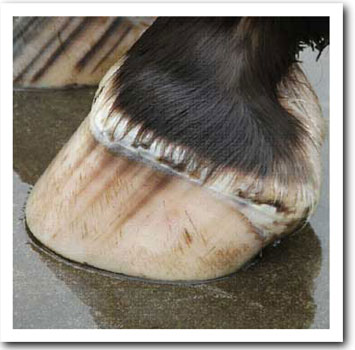
- Diet
- Movement
- Trimming
*Note Diet ‘trumps’ Movement.
Some people will vehemently disagree but I believe it to be true. There are thousands of horses who live very confined lifestyles (stabled or penned) but who are still being ridden well into their 20’s and 30’s compared to horses who live out on grass all their lives whose useful life is more often than not ‘finished’ well before they are 20.
Ideally you can address all 3 points equally well, thereby achieving strong, healthy hooves.
You can exercise and ride a sane horse and the more exercise they get the less you need to trim.
If your horse has weak, shaly hooves it will take 9-12 months on a high fibre, minerally balanced diet for the new hoof capsule to grow down with the necessary quality.
Diet
The coarse fibrous material of a high fibre diet keeps the flora in the horse’s hind-gut healthy.
The gut-flora ferments the fibre to produce energy for the horse. As a by-product of this process plenty of B Vitamins are produced. Biotin is just one of these B Vitamins essential for healthy hooves and hair-coats.
Having the horse produce his own Biotin is obviously preferable to buying it from the feed store!
These horizontal, parallel lines around the hoof wall  are known as ‘grass rings’. They are common in horses on pasture and are caused by the effect of seasonal and weather-related ‘flushes’ in the grass on the integrity of the hoof.
are known as ‘grass rings’. They are common in horses on pasture and are caused by the effect of seasonal and weather-related ‘flushes’ in the grass on the integrity of the hoof.
They are ‘not good’ as they are markers of damage to the delicate laminae below the wall surface.
When the horse is no longer subjected to any of these changes in the grass, the wall grows down nice and straight as in the picture at the top of the section on Hooves.
Thoroughbreds
It is false thinking that all thoroughbreds have weak, shaly hooves! They certainly tend to but this is because of the diet they are raised on. Not a diet that is conducive to producing strong, healthy hooves.
When thoroughbreds are fed a high fibre (lots of hay) minerally balanced diet they develop hooves that are just as good as any other breed. Take Nibbler in the picture below.
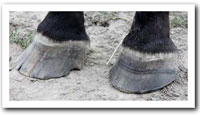
This photo was taken when he had just gone barefoot but was not being trimmed by a proper barefoot farrier. He was also not getting the correct minerals.
You can see the flares and cracks.
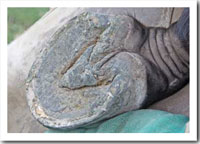
Note above the very pinched bulbs (Heels) common with Tbs who are shod at a young age. At this stage his hoove look flat (no concavity).
Here are the same hooves a year later with correct nutrition, trimming and exercise...
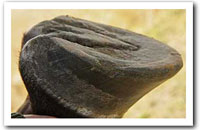
Note the hoof is no longer flat but has a nice concavity. This is NOT caused through cutting into the sole of the hoof but occured naturally with diet, movement and correct trimming. They are also rock hard - he could motor over river beds no problem at all!
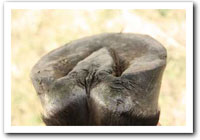
Note that his heels are starting to decontract!
Movement
Horses are meant to move! They love to move! Movement is actually a necessary part of the circulatory system of the horse, vital for pumping blood back up the legs from the hoof.
Therefore horses need to be as free as possible to move.
Horses in the wild cover many kilometres a day between the water-hole and their grazing areas. They are more or less constantly on the move over a variety of terrains.
The trouble is that as real estate becomes less available and more expensive, life becomes more and more confined for domestic horses.
The challenge is to create a living environment for your horse that encourages him to move as much as possible.
Read “Pasture Management”
Keeping horses cooped up in a ‘little square’ pen or stable 24/7 is not good for their health or mental well-being. It is the equivalent of keeping a seal in your bath-tub!
For some people in some situations it is necessary and OK to stable or yard their horse at night, and their horses can be perfectly happy and healthy.
I also know of head-shaking horses who are better off stabled and free of the terrible affliction than out on the ‘wrong’ grass, beside themselves in distress from flicking their head and not being able to stand the sunlight.
Sometimes it is a compromise but a major point is that when your horse is calm and healthy you can ride him!! That’s fabulous exercise for you and him.
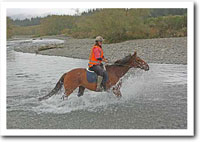
This is Nibbler thundering over the river stones - no problem for his bare thoroughbred feet!
Trimming
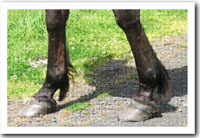
Flares/Poor Trimming Practice
This poor horse (above) had been crippled by poor trimming. The heels had been lowered but the toe left long. The whole hoof ends up way out in front of the bone column it is supposed to support.
A consequence is that ‘break-over’ is delayed and for the horse it is just like you trying to walk with flippers on your feet. The resulting strain on the muscles, tendons & ligaments of the horse’s fore-quarters, back and hind-quarters causes discomfort, soreness and ultimately soundness issues.
The excessive flare out the front means the laminae is stretched from the white line up and the only ‘connection’ left is the top couple of centimetres near the coronet.
Every step the horse takes pulls the wall away from the coffin bone even more. This horse was in grave danger of losing that last bit of connection, whereupon the wall and the coffin bone are completely separated and the coffin bone ‘sinks’. This condition is also known as ‘mechanical founder’ and is man-made!
Stretched white line/Seedy Toe
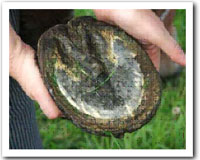
If you don’t want seedy-toe then definitely don’t let this happen. See the stretched white line in the photo left.
In fact there now is no white-line which is meant to be the waxy substance which forms the seal at the bottom of the laminae and prevents foreign material entering the hoof.
When it is mechanically stretched because of a flared hoof wall, the door opens for pathogens, soil, tiny stones etc to work their way up into the hoof.
Be fanatical not to let this happen by keeping the hoof diligently trimmed at least once a month so no flare ever happens.
To check: Take the straight surface of a ruler or rasp and lay it down the hoof wall. If you can see daylight between the object and the wall then you have flare. You may not be able to get rid of it all in one trim but over several it should be gone forever.
 Calm Healthy Horses
Calm Healthy Horses